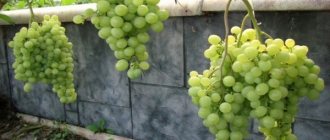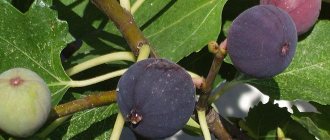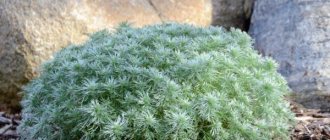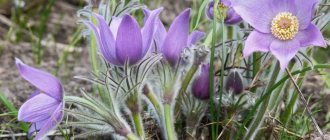Features of cultivation
In the Leningrad region, where summers are short, grapes grow not only in greenhouses. It can be grown in open ground without any problems. The soils in this region are acidic, so ash and dolomite flour must be added annually, starting from the year of planting. The grapevine begins to bear fruit 3 years after planting. The grapes gain more sugar if the grapes grow in a well-lit area of the garden. Cover the vine only for the winter. Grapes are afraid of thaws and January rain.
Covering material is removed from the bushes immediately after the snow melts. A delay in removing polyethylene can lead to freezing of the shoots. A covered vine grows before the onset of consistently warm weather; return frosts are dangerous for it. It is recommended to spray grapes of any variety that have woken up ahead of time when there is a threat of low temperatures with agents that enhance immunity:
- “Tsitovit”, “Epin”, “Extrasol”;
- "Epinom" together with "Ecofus".
After processing, the grape bushes are covered with non-woven fabric (spunbond). To restore frozen grapevines, they are sprayed with the Zircon preparation.
Features of planting grapes for the northwest
Growing grapes requires certain skills and knowledge. But, even if you are not a winegrower, everything will work out.
Note! Grapes do not like acidic soil. Taking into account this feature of the soil in the Leningrad region, lime, as well as organic and mineral fertilizers, should be added to the planting hole. Experience will appear during the growing process, and the theoretical part can be gleaned by reading the article to the end
Experience will appear during the growing process, and the theoretical part can be gleaned by reading the article to the end.
- It is recommended not to plant the seedlings immediately, but to leave them outside directly in the container for several days. First you need to put it in the shade, then move it to partial shade, and only then to a sunny place. In this way, the plant gradually gets used to new conditions. You can plant grapes after the end of spring frosts and before the cold autumn.
- To plant grapes, you need to choose a sunny place on a hill. An excellent option would be to plant it near the wall of the house. This way the grapes will have somewhere to wander. Another advantage is that the wall, having warmed up during the day, will give off its heat at night. In addition, it is simply very beautiful at any time of the year. It should also be taken into account that the planting site must be protected from drafts.
- It is better to plant a grape seedling in black soil or forest soil. To make the soil more loose, you can add sand. The humus layer should be at least 60 cm deep, preferably 1 m.
- Varieties growing in open ground need to be covered with special material in early May, even if the variety is not covered. It is also better to cover the plant for the winter, especially after pruning it is not difficult to do. A good way is to cover it with a wooden box. You can make a canopy from polycarbonate. Another option is to bend the plants to the ground, cover with film and sprinkle with soil. The result will be a kind of greenhouse that will be covered with snow in winter. This is excellent protection against severe frosts. The cover can be removed in the spring, when the snow begins to melt, but it is better to wait until the frosts end.
- Every year you need to prune the bushes (starting from the first year) according to this principle: immediately after planting, the shoot is cut into two buds, from which two shoots will grow. For pruning the plant, pruning shears, a garden saw, a knife, and a garden pitcher are suitable.
- In autumn, in the first year after the leaves fall off, one shoot is pruned into two buds (in the future this will be a replacement branch), and the second into 8-10 buds (fruit vine). Next year, two shoots will grow again from the replacement twig. They should be pruned again as last fall. If flower clusters appear on the fruit vine, it is better to leave 2-3 and cut off the rest.
- In the fall, the entire fruit vine is cut out. The grapes begin to bear fruit in 3-4 years.
- As a preventative measure, each pruning should be accompanied by treating the plant against parasites and various diseases. Treatment is carried out as needed.
Important! You should not leave more than 30 bunches on an adult plant, otherwise, most likely, they will not ripen
The best grape varieties for the Leningrad region
The winegrowers of the Leningrad region have a lot of practice. You can safely choose varieties that they have already tested in their vineyards. It is worth planting proven non-covering varieties with early ripening periods.
The Latvian hybrid Zilga is always popular. The bushes can withstand 30-degree frosts. Ripe bunches can hang for a long time without losing their presentation. There are no problems with pollination; the variety is self-pollinating.
Ripe berries acquire a dark blue color, and notes of nutmeg are formed in their taste. One bush produces up to 12 kg of berries.
Express Early tolerates frost up to 32 °C. Dark ripe fruits contain up to 28% sugars, which explains their good taste. They make excellent homemade wines. The weight of one bunch can reach up to 300 g. The harvest is harvested from late July to mid-August. Productivity does not decrease due to bad weather.
The Supaga variety is suitable for frost resistance in the Leningrad region. Frosts down to -25 °C are not scary for him. The clusters fill early and weigh from 300 to 600 g. The berries weighing up to 5 g have a simple, no-frills taste. Their color is amber. The variety has weak resistance to phylloxera, but it is rarely susceptible to rot, mildew, and oidium.
Cognac lovers plant Vandal Cliche. This is a wine variety from Canada. It ripens early, is very disease resistant, and is productive. The berries are medium in size, white in color, apple-pear aroma. Not quite ripe grapes are cut off for wine. This takes the Isabella notes out of the drink.
Violet early was bred in the Rostov region. Berries are used in many ways (wine, juice, fresh consumption). The bunches ripen in 130 days. Their harvesting begins in early September. The load on the bush is normalized. The berries are not large (up to 3 g), purple with a waxy coating. They are collected in small clusters weighing about 200 g. The second wave of fruiting occurs on the stepsons.
See also
Description and characteristics of Merlot grapes, its advantages and disadvantagesRead
The hybrid form Veres was bred in Ukraine, author V.V. Zagorulko. Grape fruits do not have seeds. They ripen early (90-100 days). The clusters are cone-shaped, large, weighing from 600 g. The taste of the pulp contains nutmeg.
Solaris is a wine variety bred in Germany. Ripens early. The fruits are white, round, and contain up to 22% sugars in the pulp. The variety has good resistance to mildew and oidium, but the berries suffer from wasps.
The Black Pearl variety ripens in September. The bunch size is medium. The berries are dark blue, medium-sized, round-conical. The pulp has a pronounced aroma of nutmeg, the taste is harmonious and rich. Frost resistance at -26 °C. The variety's immunity to mildew and oidium is average.
Other varieties for open ground:
- Khasansky Sweet;
- Galant;
- Regent;
- First Michurinsky;
- P34;
- P33;
- Danko;
- Muscat Blau.
Other varieties are suitable for greenhouses. For example, Laura grapes are grown near St. Petersburg. This is a table culture. The clusters are large, conical, dense. The ripening period lasts at least 120 days. Frost resistance is not bad (-23 °C).
Kishmish Radiant is an old Moldavian variety; the clusters ripen in 130 days. It is also successfully grown indoors. Ripe berries are pink in color. The shape of the fruit is oval, elongated. The taste has a hint of nutmeg. The plant is susceptible to mildew and oidium.
All about the dacha
Beginning gardeners who decide to plant fruit grape seedlings in their garden or summer cottage should remember that this is a very light and heat-loving plant.
Therefore, the place must meet its requirements. After all, we want to get not only decorative climbing vines, but also a good harvest of berries in the future. What to do if you want to plant a southern grape plant in the middle zone and northern region? We share the main aspects of agricultural technology for successful cultivation, planting in the middle part, central and in the zone of unsustainable (risky) agriculture of Russia.
Choose new developments in the selection of species that are resistant to winter cold; for beginners, we recommend these grape varieties for central Russia:
- “Alpha”, “Arcadia”, “Harold”, “Laura”, White Miracle, “Transfiguration”; “Isabella”;
- for more northern regions - frost-resistant hybrids, “Taiga”, “Valiant”, “Beauty of the North”, “Thumbelina 3”, some species from Amur hybrids that are not covered.
- For the Urals and Siberia, the grape varieties Aleshenkin, Muromets, Zimostoykiy (Pamyat Dombkovskaya), Zhemchug Saba, Alpha, Amursky, Muscat Maria and white are well suited for planting and growing grapes.
Now we will tell you how to decide on the period, prepare the plant for planting, harden it correctly, take into account the soil in which the grapevine will grow in order to correctly carry out agrotechnical care and planting operations.
Greenhouse or open ground?
Early varieties grow well in open ground. Basic care for them comes down to pruning and covering the vines with cellophane for the winter. In a greenhouse, the berries ripen earlier, but from the observations of winegrowers, in closed ground one has to spend time fighting pests and diseases.
The berries of greenhouse grapes are fleshier, larger, and ripen by mid-July. In the soil the clusters are noticeably smaller, the berries are medium in size. In warm summers, the clusters ripen by mid-August, in the cool season - by mid-September.
Cons of a greenhouse:
- there is less snow than outside, the soil freezes deeper;
- in the spring, due to early awakening, the vine may suffer from frost;
- for good growth and disease prevention, it is necessary to use chemicals (growth stimulants, fungicides);
- In the summer, frequent, abundant watering is needed.
The advantages of greenhouse grapes include a wider list of varieties that can be grown in the conditions of the Leningrad region, and ripening periods. The berry picks up sugar 3 weeks earlier than in open ground. Supporters of environmentally friendly harvests and simple care choose open ground.
My vineyard is 90 km from St. Petersburg
My estate, which is 50 acres of land, which I registered in 2010, although the house and plot have been in use since February 1945. Since 2006, I became an heiress and put in order the house built before 1940 and completely updated the old garden. This is the village of Slavyanka, Priozersky district, Leningrad region.
Since 2010, she began growing grapes. Many thought that this was a whim and the grapes would not bear fruit, but when you look at the vineyards of the Krasnodar Territory, you really want to grow these beautiful and tasty varieties. I started with 4 bushes of varieties: Delight oval, Laura (Flora), Pamyati Dombkovskaya -2 bushes. Two bushes of Pamyat Dombkowska consisted of 2 cups in one of which was a plant of 2 grape leaves, the other of 3 leaves. Delight oval and Laura were annual bushes. And the most interesting thing is that in the fall of 2010, Laura gave me one berry, which inspired me and I realized that my grapes would grow. In 2011 I bought 7 more varieties of grapes, in 2012 11 more varieties. In 2014, 12 varieties already began to bear fruit.
How grapes develop. Grape seedlings are sold at the age of 1 year or 2 years old. In our climate, it begins to bear fruit in the 3rd year, when the vine gains strength. Type of seedling:
For the Leningrad region, it is necessary to select early and very early grape varieties that will have time to collect juices and sugar and ripen during our short summer. Since summers in our region can be cold and rainy, like June 2014, it is better to grow grapes in a greenhouse (although some varieties are suitable for greenhouses). In the greenhouse, harvests are reliable even in cold summers. I grow it in a greenhouse, because grapes do not like cold and prolonged cold rains (the root system of young seedlings may rot). The greenhouse not only provides a warmer air temperature, but in rainy summers you can always limit watering and the development of the grapes will be complete. In the southern regions, many chemicals are used for grape diseases; in our region, grapes do not suffer from southern diseases. In rainy summers, rot may appear, but for this, in the spring before the leaves appear and in the fall before sheltering for the winter, the vines are sprayed with TOPAZ and that’s it. Grapes love spraying with microelements; the best fertilizer for vines is fertilizers with AVA type microelements. Fertilizers containing NITROGEN cannot be used in the vineyard in our region, as the vines will not ripen well. And the ripened vine produces a harvest. The annual vine bears fruit, so pruning and shaping are used on the grapes.
Grape varieties in my vineyard: 1. Laura 2. Delight oval 3. In memory of Dombkovskaya (kishmish variety) 4. Platovsky 5. Aleshenkin (Alyosha) 6. Rodina 7. Crystal 8. Ilya Muromets 9. Early Malingera 10. Harold 11. Kish -Mish 342 12. Beauty of the Don 13. Beauty 14. Kish-Mish Radiant 15. Super-Extra 16. Arcadia (Nastya) 17. Libya 18. Bulgarian Cardinal 19. French Cardinal 20. Transfiguration
Planting dates and tips
You need to plant grapes in a pre-prepared area. At least 1 m² of land must be allocated per bush - 2 x 0.5 m. A deep hole is not needed. It is enough to deepen it 60 cm. In places with high soil moisture, drainage in the form of broken bricks, gravel, and crushed stone is poured onto the bottom.
See also
Description and characteristics of Venus grape variety, planting and cultivationRead
In clay soil, the root system develops poorly, so in addition to organic matter, mineral fertilizers, and ash, sand is added to the soil mixture to fill the hole. Seedlings are planted in the spring immediately after the soil has completely warmed up. In summer the plant takes root and overwinters without problems.
In the summer months, you can plant seedlings with a closed root system; with good care, they take root no worse than grapes planted in the spring. Winegrowers in the Leningrad region also practice autumn planting, but the seedlings are hilled up and well covered for the winter.
Necessary conditions for growing grapes in the garden
The most important requirements for cultivation are:
- fertile soil;
- appropriate place;
- correctly selected variety;
- sufficient moisture and sun, as well as positive emotions.
Like any other plants, grapes will respond with gratitude for the work and energy invested.
Soil preparation
Both sand and fertile black soil are suitable for cultivation. The grapes are not picky about the quality of the soil, but there are some nuances. If the soil contains a lot of clay, then it should be provided with drainage.
If, on the contrary, there is a lot of sand, then add more fertilizers and manure. Be sure to measure the acidity of the soil: if the pH is below 6, then treat with lime (200g per 1 m²). Increased salinity can also negatively affect grapes. You should not choose low-lying places where water can linger. Grapes do not like excess moisture.
Landing location
Proper planting and care of grapes play a major role in the growing process, so you need to carefully choose the location. South-facing sides of buildings are best so that the sprouts receive sufficient light and warmth throughout the summer. This will strengthen the root and increase its chances of surviving the winter.
Grape planting and care: how to choose a place
If it is not possible to plant grapes on the south side, you can make a deeper planting hole (add 20 cm in depth). Remember: if you save the root, the whole plant will survive.
Choosing the right variety
There are many varieties suitable for cultivation in Russia
When choosing, pay attention to the desired ripening period; it should correspond to the warmest time of the year in the area. You should also consider the frost resistance of the bushes and whether they need to be covered for the winter. Choose grape varieties based on frost resistance
Choose grape varieties based on frost resistance
Caution never hurts: it is better to cover the grapes, regardless of the variety. It is also necessary to lower the vine and press it to the ground before wintering. For the Leningrad region and Moscow region, you can choose different varieties, for example, Amur grapes are suitable for planting and caring for which will not require a lot of effort
For the Leningrad region and the Moscow region, you can choose different varieties; for example, Amur grapes are suitable for planting and caring for which will not require much effort.
Illumination and warmth
The grapes are heat-loving, but in extreme heat (over +35°C) they can slow down their development. The darker the color of the berries, the more heat this variety requires, and vice versa. A slightly shaded area is ideal for growing.
How to properly care?
Formative pruning is the main element of care. It starts from the second year of the vine’s life. Carry out in the fall throughout the life of the bush. After harvesting, almost the entire above-ground part is cut out. First of all, remove all fruit-bearing shoots. The vine that has not ripened is also cut out. She won't survive the winter anyway. The main thing is to start forming the bush correctly. The winegrowers of the Leningrad region are supporters of fan pruning. Lay 4 sleeves.
When pruning in autumn, both methods are used:
- with a replacement knot;
- without a bit of substitution.
For fruiting shoots, the most powerful branches with mature wood are selected and shortened by 5-6 buds.
After pruning, a small above-ground part remains; covering it for the winter is not difficult. Plastic arcs are installed, cellophane is stretched over them. It turns out to be a tunnel, the ends of which are open. The shelter protects not from frost, but from thaws, which, due to the specific climate, often occur in January.
During the season, the vine is watered 4 to 5 times. In wet seasons, the volume of irrigation water is reduced. Starting from the 3rd year of life, they begin to add:
- ash;
- dolomite flour;
- humus;
- mineral fertilizers.
Grape propagation
A new bush of the variety you like can be obtained using layering and cuttings. The latter are harvested in the fall during pruning. Completely lignified shoots are selected for propagation. The core of the cutting should be green. The shoots are kept in water until the roots appear. For better germination, maintain a room temperature of 20 to 23 °C. Prepare containers with fertile soil. Seedlings are grown in them until they are planted in a permanent place.
For layering in the fall, take a healthy cane, break out all the shoots, and remove all the leaves. The middle part of the shoot is sprinkled with fertile soil, leaving the crown above the ground. The growth of grape shoots begins the following spring. From the cuttings they begin to form a new bush. It is separated from the mother bush after 3 years.
Preparing grapes for planting
Only healthy seedlings are used.
Drying the plant is strictly prohibited. Before planting the seedling, the plant must be kept in water for about 1 day. Then the seedling needs to be trimmed, leaving 4-6 buds.
A good seedling can have three roots. The thickness must be more than 1 mm. Before planting, the roots must be dipped in a clay mixture. You can treat the plant with Dnoka solution (5 grams of solution per 1 liter of water).
Proper hardening of seedlings
Green seedlings that are in the process of growing must be hardened off. Without additional protection, they will not be able to withstand direct sunlight. To begin with, they are kept in the shade of trees or under a roof for about 6 days. Then they are transferred to the sun for a week. If the seedlings grew in poor lighting, hardening should be increased. This deficiency can be noticed by the light-colored leaves and elongated shoots. If such seedlings are planted in the spring, the cool soil will be regarded as the arrival of autumn. At the same time, the plant stops growing and begins preparing for autumn. It's not scary. In mid-summer, the grapes will acclimatize and resume growth.
Planting grape seedlings in clay or black soil
To plant a mature plant, you need to prepare a hole 80X80X80 cm. Now you need to lay the nutrient base to a depth of approximately 25 cm.
The nutrient mixture will consist of 8 buckets of fertilizer and fertile soil to the required level. The next layer of about 10 cm should be mixed with 300 grams of superphosphate, potassium-based fertilizer and 3 tablespoons of ash.
Sprinkle soil on top. Ultimately, the hole should remain approximately 50 cm.
In the hole you need to make a small tubercle and, placing a grape seedling on it, straighten the root system. Place a stand nearby (a ladder for vines to grow and cling to).
Then the hole is filled with regular soil without fertilizers. Place a stand (ladder for vines to grow and cling) tightly and steadily nearby. After planting, there should be a hole approximately 25 cm deep. The soil in the hole should be compacted a little and three buckets of liquid should be poured onto one bush.
Diseases and pests
Most grape varieties grown in the Leningrad region are resistant to diseases. Their possibility should not be ruled out. Therefore, prevention of mildew, oidium, and gray rot is necessary. The topic of diseases is especially relevant for greenhouse grapes. To prevent fungal diseases, control the humidity level, spray the soil and shoots with fungicides.
Dangerous pests include:
- spider mite;
- leaf roller (grape);
- grape itch;
- phylloxera.
Fungicides are also used against them throughout the season. It is possible and necessary to engage in viticulture in the climate of the Leningrad region, despite the short summer, and obtain decent harvests of berries. Success is achieved by gardeners who select the right varieties and take into account the peculiarities of the local climate when growing grapes.
All about the dacha
Beginning gardeners who decide to plant fruit grape seedlings in their garden or summer cottage should remember that this is a very light and heat-loving plant. Therefore, the place must meet its requirements. After all, we want to get not only decorative climbing vines, but also a good harvest of berries in the future.
What to do if you want to plant a southern grape plant in the middle zone and northern region? We share the main aspects of agricultural technology for successful cultivation, planting in the middle part, central and in the zone of unsustainable (risky) agriculture of Russia.
Choose new developments in the selection of species that are resistant to winter cold; for beginners, we recommend these grape varieties for central Russia:
- “Alpha”, “Arcadia”, “Harold”, “Laura”, White Miracle, “Transfiguration”; “Isabella”;
- for more northern regions - frost-resistant hybrids, “Taiga”, “Valiant”, “Beauty of the North”, “Thumbelina 3”, some species from Amur hybrids that are not covered.
- For the Urals and Siberia, the grape varieties Aleshenkin, Muromets, Zimostoykiy (Pamyat Dombkovskaya), Zhemchug Saba, Alpha, Amursky, Muscat Maria and white are well suited for planting and growing grapes.
Now we will tell you how to decide on the period, prepare the plant for planting, harden it correctly, take into account the soil in which the grapevine will grow in order to correctly carry out agrotechnical care and planting operations.











